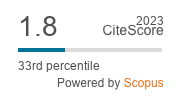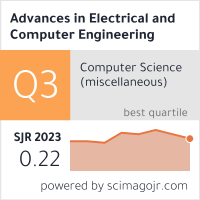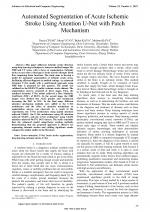| 1/2025 - 4 |
Automated Segmentation of Acute Ischemic Stroke Using Attention U-net with Patch MechanismCINAR, N. |
| Extra paper information in |
| Click to see author's profile in |
| Download PDF |
Author keywords
attention U-Net, brain stroke segmentation, deep learning, ischemic stroke, U-Net
References keywords
segmentation(32), stroke(17), brain(11), network(10), ischemic(10), lesion(9), attention(9), neural(7), multi(7), images(7)
Blue keywords are present in both the references section and the paper title.
About this article
Date of Publication: 2025-02-28
Volume 25, Issue 1, Year 2025, On page(s): 29 - 42
ISSN: 1582-7445, e-ISSN: 1844-7600
Digital Object Identifier: 10.4316/AECE.2025.01004
SCOPUS ID: 105001301554
Abstract
This paper addresses ischemic stroke detection using deep learning techniques to interpret medical images like MRI and CT scans, with a focus on segmentation. Ischemic stroke occurs when a blockage in brain arteries disrupts blood flow, impairing brain functions. The study aims to develop a model for automatic segmentation of ischemic stroke areas, facilitating efficient diagnosis in medical settings. An enhanced Attention U-Net model with a patch-based approach using MRI data is proposed for this purpose. The model was validated on the ISLES22 public ischemic stroke dataset. The segmentation process consisted of three stages. First, the standard Attention U-Net model achieved a Dice Similarity Coefficient (DSC) of 88.9%. In the second stage, the MRI images were divided into 32x32 patches and reanalyzed, increasing the DSC to 93%. In the final stage, different attention mechanism methods were added to the U-Net architecture and the effect of attention mechanism on segmentation success was observed. As a result of the experiments, the U-Net architecture using spatial attention achieved 94.86%, the U-Net architecture using SE attention achieved 95.40%, and the U-Net architecture using CBAM attention achieved 96.47% DCS success. The study concludes that the enhanced model outperforms existing methods, demonstrating that the proposed approach is effective for segmenting ischemic strokes and yielding significant results compared to similar studies in the literature. |
| References | | | Cited By |
Web of Science® Times Cited: 0
View record in Web of Science® [View]
View Related Records® [View]
Updated 4 days, 15 hours ago
SCOPUS® Times Cited: 0
View record in SCOPUS® [Free preview]
There are no citing papers in the CrossRef Cited-by Linking system.
Disclaimer: All information displayed above was retrieved by using remote connections to respective databases. For the best user experience, we update all data by using background processes, and use caches in order to reduce the load on the servers we retrieve the information from. As we have no control on the availability of the database servers and sometimes the Internet connectivity may be affected, we do not guarantee the information is correct or complete. For the most accurate data, please always consult the database sites directly. Some external links require authentication or an institutional subscription.
Web of Science® is a registered trademark of Clarivate Analytics, Scopus® is a registered trademark of Elsevier B.V., other product names, company names, brand names, trademarks and logos are the property of their respective owners.
Faculty of Electrical Engineering and Computer Science
Stefan cel Mare University of Suceava, Romania
All rights reserved: Advances in Electrical and Computer Engineering is a registered trademark of the Stefan cel Mare University of Suceava. No part of this publication may be reproduced, stored in a retrieval system, photocopied, recorded or archived, without the written permission from the Editor. When authors submit their papers for publication, they agree that the copyright for their article be transferred to the Faculty of Electrical Engineering and Computer Science, Stefan cel Mare University of Suceava, Romania, if and only if the articles are accepted for publication. The copyright covers the exclusive rights to reproduce and distribute the article, including reprints and translations.
Permission for other use: The copyright owner's consent does not extend to copying for general distribution, for promotion, for creating new works, or for resale. Specific written permission must be obtained from the Editor for such copying. Direct linking to files hosted on this website is strictly prohibited.
Disclaimer: Whilst every effort is made by the publishers and editorial board to see that no inaccurate or misleading data, opinions or statements appear in this journal, they wish to make it clear that all information and opinions formulated in the articles, as well as linguistic accuracy, are the sole responsibility of the author.



